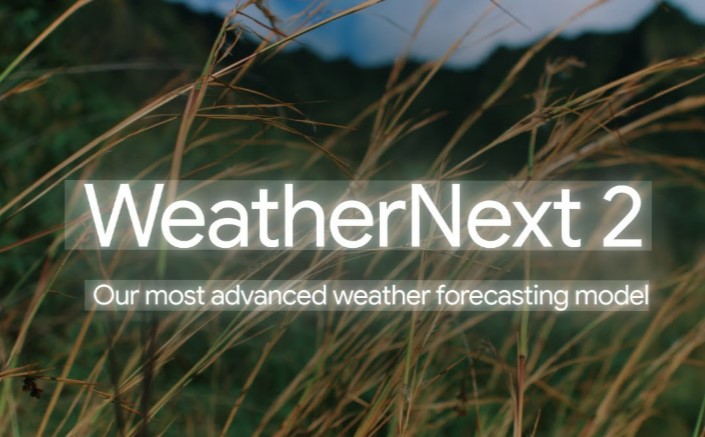Google has officially announced WeatherNext 2, its latest artificial intelligence-powered weather forecasting model. Unlike conventional physics-based systems, this model generates weather predictions faster and more accurately, making it a game-changer for both everyday users and businesses that rely on timely meteorological data.
Integrated into Google’s ecosystem—including Search, Gemini, and Pixel Weather—WeatherNext 2 brings cutting-edge AI predictions directly to end-users, providing an unprecedented level of detail and speed.
WeatherNext 2: Eight Times Faster Than Its Predecessor
The most striking feature of WeatherNext 2 is its speed. According to Google, the new AI model produces forecasts eight times faster than the previous generation. This acceleration does not compromise accuracy; in fact, it provides up to 99.9% precision for temperature, wind, and other key variables.
At the heart of this rapid forecasting is Google’s Tensor Processing Unit (TPU) technology. While traditional physics-based models can take hours on a supercomputer to simulate weather scenarios, WeatherNext 2 generates hundreds of potential outcomes in under a minute.
Traditional vs. AI-Based Forecasting:
- Conventional models: Recreate the complex physics of the atmosphere, requiring massive computational resources.
- AI models: Analyze patterns from historical weather data to predict future conditions efficiently and accurately.
Functional Generative Network (FGN): The AI Behind the Speed
Google’s WeatherNext 2 leverages a proprietary system called Functional Generative Network (FGN). Unlike older AI models that needed repeated calculations for every forecast, FGN introduces controlled randomness, allowing the model to produce multiple possible outcomes in a single step.
This innovation enables hourly updates and forecasts up to 15 days in advance, giving both individual and corporate users a significant advantage in planning and risk management.
Akib Uddin, Product Manager at Google Research, stated:
“Industries like energy, agriculture, transportation, and logistics greatly benefit from hourly forecasts. These insights allow businesses to make more informed, precise decisions that impact operations directly.”
Integration Across Google Platforms
WeatherNext 2 is not limited to internal research. Google has integrated the model into multiple platforms:
- Google Search: Users can access highly accurate weather data directly in search results.
- Gemini: The AI companion now leverages advanced weather forecasts for contextual insights.
- Pixel Weather: Smartphone users receive faster, more precise weather alerts.
- Google Maps Weather API: Developers and enterprises can integrate WeatherNext 2 data into their own applications.
Additionally, the early access program allows clients to create customized weather models based on WeatherNext 2, while Earth Engine and BigQuery users can conduct geospatial and large-scale data analysis using these forecasts.
How WeatherNext 2 Outperforms Traditional Models
WeatherNext 2 represents a shift from conventional numerical weather prediction. Here’s how it excels:
- Speed: Generates hundreds of scenarios in under a minute on a single TPU.
- Accuracy: Provides nearly perfect predictions for temperature, wind, and humidity.
- Scalability: Supports forecasts for up to 15 days with hourly resolution.
- Efficiency: Uses historical patterns to minimize computation, reducing energy usage and operational costs.
- Scenario Diversity: Allows meteorologists to explore multiple possibilities for risk management, critical during extreme weather events.
This approach is particularly valuable for industries dependent on predictable weather, such as energy production from wind farms, agricultural scheduling, or transportation logistics.
WeatherNext 2 and DeepMind’s GenCast Legacy
Google’s AI weather initiatives are not new. WeatherNext 2 builds on lessons learned from GenCast, developed by DeepMind. GenCast analyzed over 40 years of high-quality European weather data and demonstrated better performance than the European Centre for Medium-Range Weather Forecasts (ECMWF) models.
WeatherNext 2 takes this further:
- Single TPU efficiency: Produces 15-day forecasts in under 8 minutes.
- Functional Generative Network: Ensures physically realistic yet flexible predictions.
- Global reach: Provides highly accurate forecasts across multiple continents, surpassing previous AI and traditional models.
Benefits for Businesses and Governments
WeatherNext 2 offers significant advantages beyond daily forecasts:
- Energy Sector: Optimizes production from solar and wind sources based on precise forecasts.
- Agriculture: Enables crop management with hourly and daily projections, reducing risks from unexpected weather changes.
- Transportation & Logistics: Enhances route planning and scheduling by anticipating storms or extreme conditions.
- Disaster Preparedness: Provides multiple scenario forecasts, allowing governments and emergency services to plan and respond more effectively.
The system’s hourly resolution and 15-day range make it a valuable tool for decision-making in sectors where weather volatility directly impacts operations.
Making Weather Forecasting Accessible
One of Google’s goals with WeatherNext 2 is democratizing access to accurate weather predictions. Through integration with Search, Maps, Pixel Weather, and BigQuery, a wide audience—from casual users to enterprise clients—can benefit from real-time data.
For developers and data scientists, custom models can be built using WeatherNext 2 as a foundation. These models can be tailored for specific regions, industries, or use cases, offering flexibility and advanced predictive capabilities previously unavailable in traditional weather models.
Future of AI Meteorology
Google aims to continue improving WeatherNext 2 with ongoing research in:
- Climate trend analysis: Using long-term AI forecasts to understand global climate patterns.
- Extreme weather prediction: Enhancing early warning systems for hurricanes, floods, and heatwaves.
- Integration with IoT devices: Providing precise hyper-local forecasts for smart cities and connected infrastructure.
With the combination of TPU acceleration, Functional Generative Network, and historical pattern analysis, AI-based weather prediction is moving closer to being both globally accurate and locally actionable.
Conclusion: WeatherNext 2 Redefines Forecasting
Google’s WeatherNext 2 demonstrates the potential of AI to revolutionize weather forecasting. By combining speed, accuracy, and scalability, it provides a significant edge over traditional physics-based models. From individual users checking the daily weather to industries planning operations, WeatherNext 2 offers reliable, actionable, and near real-time insights.
As AI weather models continue to evolve, tools like WeatherNext 2 may soon become the backbone of meteorological science, providing faster, smarter, and more precise forecasts than ever before.
For more information, visit Google Research and Earth Engine.

